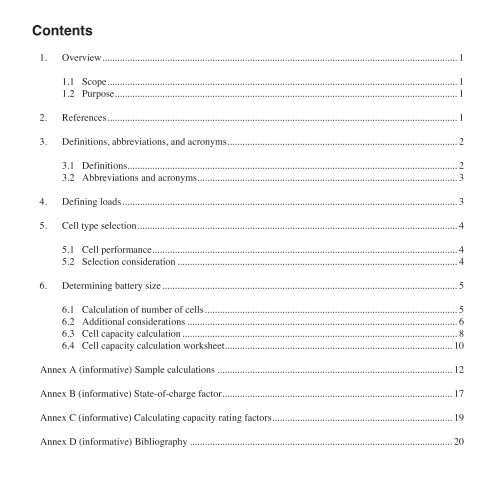IEEE 1568-2003 pdf download.IEEE Recommended Practice for Electrical Sizing of Nickel-Cadmium Batteries for Rail Passenger Vehicles
6. Determining battery size Several basic factors govern the size (number of cells and rated capacity) of the battery. Included are the minimum and maximum operating voltages, the duty cycle, design margin, and correction and derating fac- tors. Tray configurations may also be a consideration in selecting the number of cells. Since a battery is usu- ally composed of a number of identical cells connected in series, the voltage of the battery is the voltage of a cell multiplied by the number of cells in series. The ampere-hour capacity of a battery in this case is the same as the ampere-hour capacity of a single cell. If cells of sufficiently large capacity are not available, the battery manufacturer should be consulted for any limitation on paralleling. Operating conditions can change the available capacity of the battery. For example:
a) The available capacity decreases as its temperature decreases;
b) The available capacity decreases as the discharge rate increases;
c) The minimum specified battery voltage at any time during the discharge cycle limits the available capacity;
d) The charging method affects the available capacity;
e) The frequency, depth of discharge and time available for recharge affects the available capacity;
f) The battery temperature during charge affects the available capacity.
6.1 Calculation of number of cells The battery charging voltage, as well as maximum and minimum allowable system voltages, determine the number of cells in the battery. It has been common practice to use 18–20, 24-26, 36–40,48–52 or 75–90 cells for the nominal system voltages of 24, 32, 48, 64 or 110 V, respectively (IEEE Std 1476-2000 outlines the voltage ranges for 24, 32, 48 and 64 V nominal voltages).
NOTE—The use of a larger number of cells allows lower minimum cell voltage and, therefore, smaller cell capacity for the duty cycle. Initially the number of cells should be determined by dividing the nominal LVPS output voltage (see Table 4 of IEEE Std 1476-2000) by the battery manufacturer’s recommended cell voltage required for satisfactory charging at 20°C. When temperature compensation is used to control the LVPS output voltage, and battery voltage is not allowed to exceed a given maximum system voltage, the number of cells will be limited by the battery manufacturer’s recommended cell voltage required for satisfactory charging at low temperature. In this case, the initially calculated number of cells may be reexamined or compromise temperature compensa- tion requirements may be adopted.
NOTE—For dedicated off-line battery chargers the recommended battery supplier’s charging voltage can be used with- out limiting number of cells or temperature compensation.
The time required to recharge a discharged battery decreases as the charging voltage per cell increases, assuming that the charging equipment can supply the high current necessary early in the recharge cycle. Therefore, it is necessary to select the number of cells that can be adequately recharged in the time available.
6.2 Additional considerations Before proceeding to calculate the cell capacity required for a particular application, the following factors that influence cell capacity should be considered.
6.2.1 Temperature derating factor ( T t ) The available capacity of a cell is affected by the operating temperature of the electrolyte. The electrolyte temperature for stating cell capacity is typically 20°C. At temperatures below 20°C the available capacity of a cell is reduced. At temperatures higher than 20°C there is no meaningful increase in capacity. The degrada- tion in the ability of the battery to deliver electrical energy under operating temperatures below 20°C is expressed by the temperature derating factor T t . ( T t ≤ 1.0). Since the temperature derating factor T t varies based on the cell design, discharge time and end-of-discharge voltage, the temperature derating factors should be obtained from the battery manufacturer . The time of discharge has significant effect on the temperature derating factor.
Therefore, the battery manu- facturers should make temperature derating information available for at least the following discharge times: 1 sec, 1 min, 5 min, 30 min, 1 hour, 2 hours, 5 hours, and 8 hours. For other discharge times the T t factor may be calculated by interpolation. Since the available capacity on discharge always depends on the final discharge voltage, it is important that the battery manufacturers, as a minimum, make available temperature derating factors for 1.0, 1.05 and 1.1 volts per cell at the end of discharge. Table A.4 provides a sample of the hypothetical temperature derating factors for various discharge times and temperatures at a minimum discharge voltage of 1.0 volt per cell. Weather of U.S. Cities [B5] summarizes in convenient form local climatic characteristics, including Normal Daily Maximum and Normal Daily Minimum values of temperature and Extreme Record High and Extreme Record Low values of temperature in the major U.S. metropolitan areas.
NOTE—The Normal Daily Maximum and Normal Daily Minimum for each month is the average over 30 years of the highest or lowest temperature respectively in that month. Although the battery may be required to operate over a wider temperature range, it is sufficiently prudent to calculate the vehicle battery capacity based on the Normal Daily Maximum and Normal Daily Minimum values of temperature for the warmest and the coldest month of the year respectively, not on the Extreme Record High and Extreme Record Low values.IEEE 1568 pdf download.IEEE 1568-2003 pdf download
IEEE 1568-2003 pdf download

Leave a Reply